A footnote to the case of John Price of Dayhouse Farm and the deliberate damage done by this land-owner to the River Lugg in Herefordshire: Mr Price has appealed his sentence, and achieved a reduction to his prison term from 12 months to 10 months, while the fines remain as before. It would seem that the judicial view of the rights and wrongs in this case remain largely unchanged. Some articles and letters supporting Mr Price’s claims published in farming journals and the Telegraph have not met with widespread support and the wider public do seem to recognize the crime for what it is. This is an important point; had Mr Price’s actions gone unchallenged, I don’t doubt that more of our rivers would suffer similar damage from insensitive or selfish riparian owners. We like to think that farmers are the greatest preservers of the countryside and often they are, but it isn’t always the case.
 Huw Irranca-Davies SM, the Atlantic salmon Species Champion in Wales, speaking at the disappointingly attended debate.
Huw Irranca-Davies SM, the Atlantic salmon Species Champion in Wales, speaking at the disappointingly attended debate. There was some excitement in Wales last month at the news that the Senedd was due to debate the problems with diminished runs of salmon and sea trout in the principality. One member had been deputed as champion of the salmon, and another was to speak for the famous Welsh sewin or sea trout. What we actually saw as the expected “debate” began, and as the appointed champions shuffled their papers ready for their speeches, was that all the other Senedd members save only one got up and left the chamber. With a single exception, they all had something more important to do. It was a salutary lesson on how the politicians of Wales view our sport and even the tourist income which derives from it. I’m sure there would have been more interest in a debate on farming.
We started June with our border rivers very low, bright sunlight and some rather unpleasant winds from the north and east. Difficult fishing seemed to be in prospect although many anglers were trying. Salmon fishing in particular seemed to be confined to the lower reaches of the Wye below Monmouth with two sea winter fish now turning up in the reports. Might there be a chance it would turn out to be a decent summer run? David Burren and I decided to try another day on the Wiltshire Avon at Heale, although during a phone call keeper Peter Major was not optimistic. His recent guests had experienced difficult days. There were mayflies hatching, he told us, but the word from all the chalk streams including the Test was that the fish were not reacting but instead remaining stubbornly on the bottom. Peter blamed the northerly winds which he never likes much. The open valleys of the chalk country seem to suffer from contrary winds affecting the fishing much more than do the relatively narrow valleys of Wales. There again, is that just a matter of difficult casting, or are the trout really put down?
Two hours from home took us to the White Bridge over the Avon at Woodford village, where we always slow down for a brief look at the river. It looked gorgeous, brimming high to the banks, full of green weed, clear and shining in the sunlight. Despite the lack of rain, there was clearly no shortage of water in the chalk aquifers. I determined to be optimistic and begin at least with a mayfly dun pattern on a suitable 4X tippet. A couple of casts in the bubbling hatch pool of the carrier below the Turbine and a wild trout of about a pound lunged at the Monnow Gosling. I missed due to striking too soon, but this early interest seemed hopeful. A little later on the main river in the fast water above the House and still with the big fly I caught three more wild fish, 10 and 11 inches brownies these, and then two very small out of season grayling. I lost a better fish in weed. At the head of the long pool with the plane trees in front of the House I spent some time on one of the big stock fish spotted lying doggo on the bottom, but I couldn’t get him to move for anything, not for dry flies and emergers of different sizes drifted over and past him, nor for a sunken nymph twitched beside him. The wind was surely cold and my hat was blown off my head once.
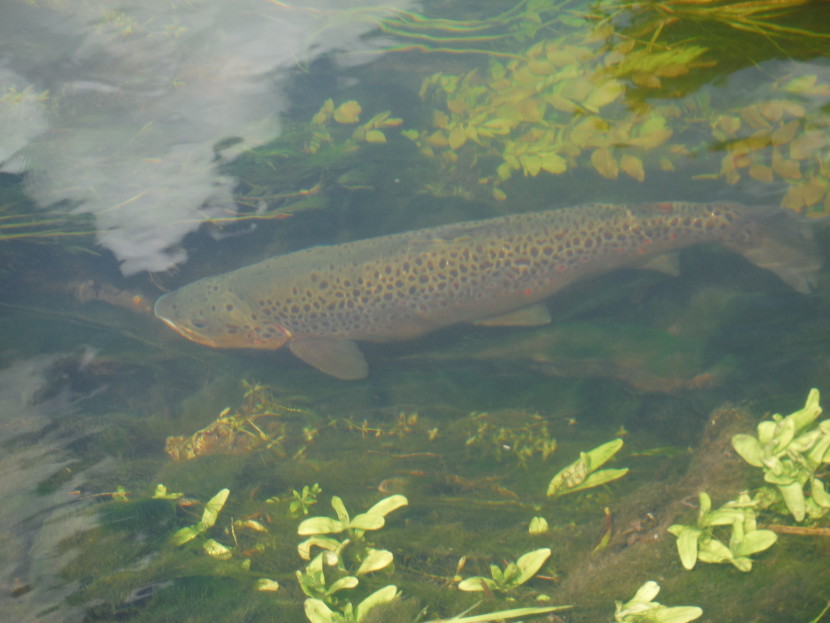 The world of the chalk stream trout
The world of the chalk stream trout 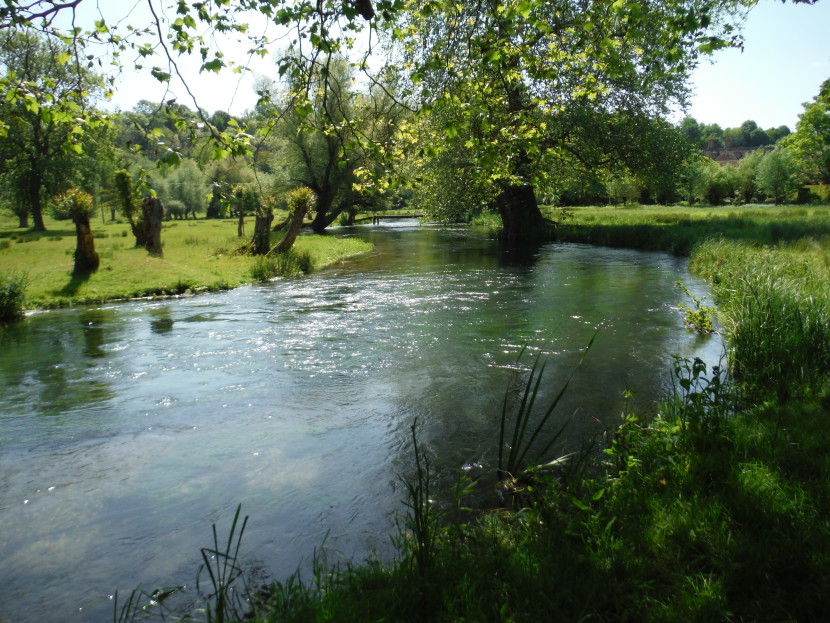 Wiltshire Avon
Wiltshire Avon Giving that one up in disgust, I walked upstream to find David struggling too, in his case sitting half-hidden in the sedges with his feet in the water and showing some large and disdainful fish lying out in front of him a variety of mostly small flies such as John Goddard’s JG Emerger. There had been no interest as yet. I went on up the left bank past him, which at least put the wind at my back, and tried to find a few more difficult fish of my own. Nearly all of them were quietly lying against the bottom. The river is too deep to wade here, so you fish from the bank across a fringe of sedges and nettles. Flies were hatching, including pale wateries, olive uprights, sedges and the odd true mayfly, but few of the big fish seemed to be excited. I found just one lying on the surface, occasionally moving lazily sideways to intercept something so small I could not see what it was. I spent some time on this fellow, went down to a 6X tippet and tried size 18 Grey Duster, Williams Favourite and some more modern and very small CDC emerger designs, in all of which he showed no interest whatever. Would he appreciate something to imitate the mayfly shucks or spinners he might have enjoyed the previous day? Apparently not. Eventually I gave him up too and carried on upstream through the water meadows with the thick tippet and size 10 Monnow Gosling on again, casting at everything I saw move until I reached the White Bridge and the village. Two small chub were all that rewarded my efforts over nearly half a mile, although I had missed a number of other rises.
However, on the way back down again, the bright sun having moved some distance across the sky by now, something seemed to change. A few more mayfly duns were visible and a couple of explosive rises clearly were not small fish. Now I find the way to fish this smooth flowing water in the open fields above the Turbine hatches, especially when the wind is at your back, is to cast right across and try to trot your dry fly down over fish lying right against the line of sedges along the far bank. You need to get it 6 inches from the edge to produce a result. Oddly enough it reminds me of the way in which, as boys, we used to trot live gudgeon down the canal under a float to catch big perch. Sure enough, after a few casts, the brown fly disappeared with a pronounced gloop, there was the sight of a big spotted brown flank and a swirl in the water as I set the hook, and before too long and after some back and forth play there was a two and a half pounder in the net. So it went on, with three more of the good ones taken in the same manner as I made my way downstream. Number three, a larger fish, managed to be a surprise in that it streaked off downstream as soon as I hooked it and spooled me all the way down to the backing. I couldn’t follow due to a large tree on my bank, so I did my best and slowly walked it back upstream, praying all the time it would not dive under the weeds. I am sure a wild one would have done just that, but gradually I regained control until a heavy shouldered 21 inch trout folded into the net.
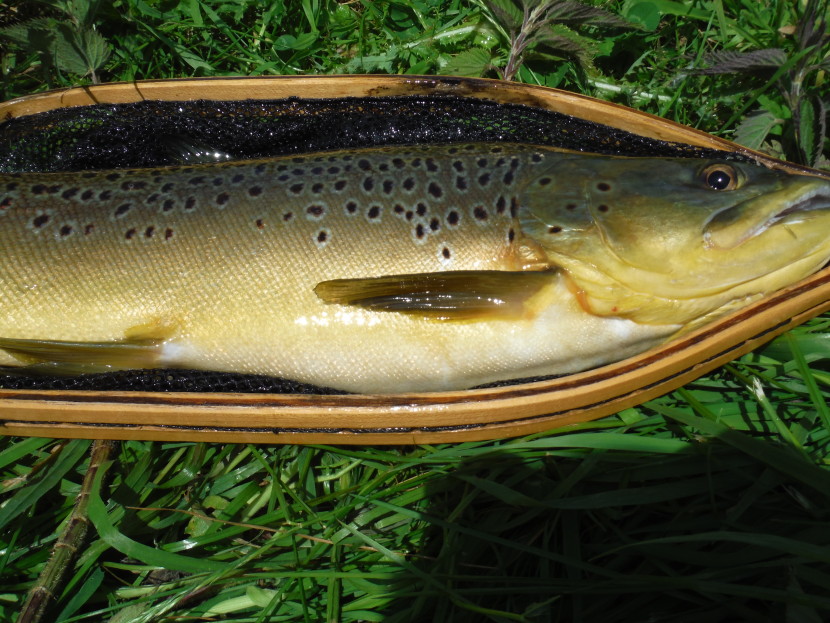 Avon mayfly feeder
Avon mayfly feeder 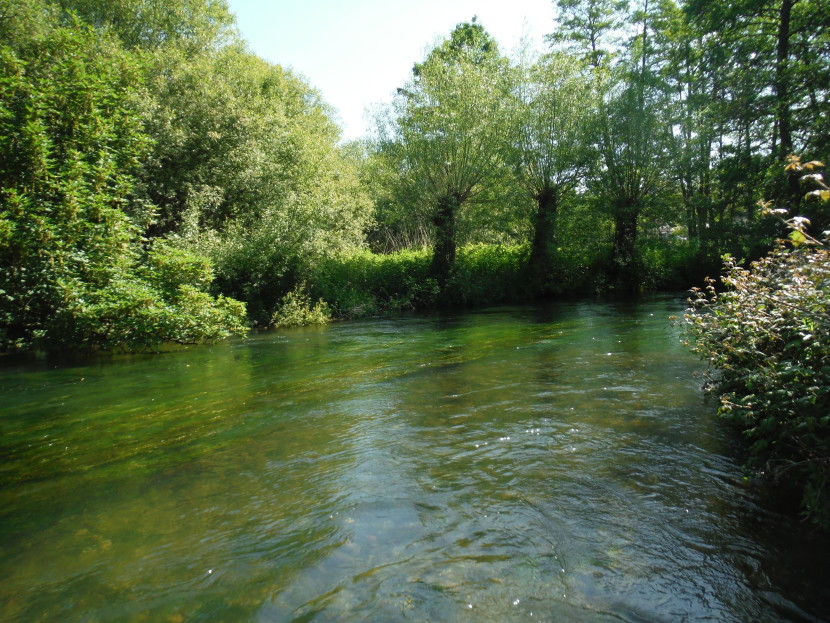 Duffers Corner at Heale
Duffers Corner at Heale So much achieved, I was just about fished out by now and retired to the Turbine hut for a late lunch or was it perhaps an early dinner, sitting talking over coffee with Peter and his son Ben, who after years of helping his father is about to leave school and enter the agricultural college at Sparsholt. They had been mowing and strimming the banks in preparation for corporate days next week. This little room built over the river is a famous place, once the haunt of chalk stream legend Dermot Wilson. It’s difficult to comment on whether one should be pleased or not about the nature of fishing such as this. Actually on reflection this is a foolish question; who wouldn’t enjoy the opportunity to catch large trout on a dry fly in such scenery? The fact of the matter is that the vast majority of the wild fish here are small, or perhaps we should say “normal” size, while the stock fish are relative giants. The biggest recently caught on this stretch of river was over 8 pounds. I like it and take it for what it is. We had another try a week later and it was still much the same, still with the same cold wind blowing to the disgust of chalk stream aficionados. Evening rises had been disappointing. Nevertheless the chalk streams seem to be as full of water as our rain-fed streams are not, and full of ranunculous weed too. Apparently the EA have decreed that there should be no weed cut on the Avon this year due to health and safety concerns. Whatever next and what would Frank Sawyer and Oliver Kite have made of that? A few very big and visible fish were feeding during this day on something very small; it was the kind of situation in which knots in the leader get taken. But there were some players prepared to take big mayfly patterns as well, more of them as the day went on and duns began to hatch. We finished up with 16 wild and stocked fish between us.
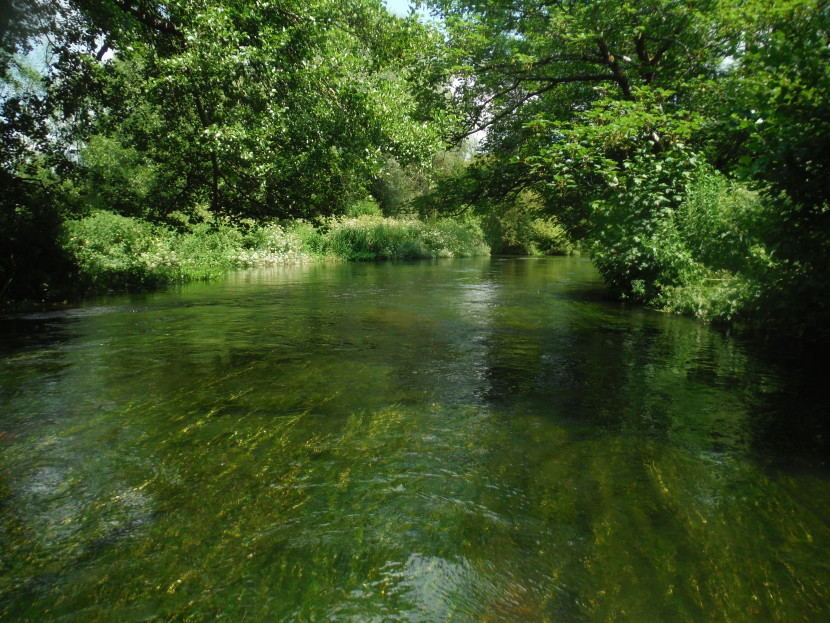 No weed cutting on the Avon this year
No weed cutting on the Avon this year 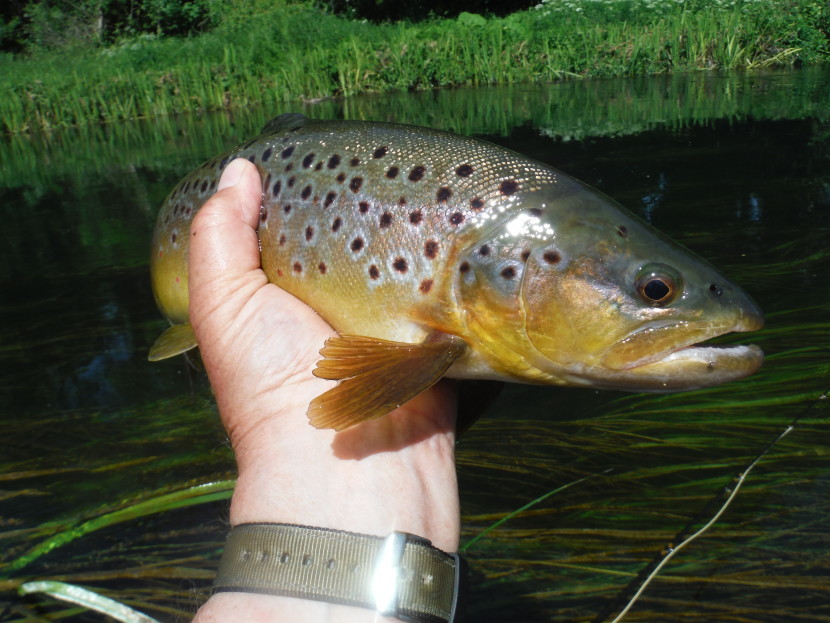 Chalk stream trout
Chalk stream trout We have had some good reports this spring from the open reaches of the upland River Tees. Just have a look at the pocket water in this picture by MR from Richmond (who took 7 trout on a small brown dry fly). The takes, he mentioned, were quite sudden and close at hand. I bet! This is exactly the sort of water which the Japanese tenkara rods were designed for and in fact I would choose my own tenkara rod on a stretch like this. Who needs a reel while you have a long rod to dabble your fly just over the next stone? Those who like fishing in high and wild places will be interested to see that RB from Caldicot reported 8 trout from Llyn Egnant at the head of the Teifi. AP from Haverfordwest with a friend had 10 trout from the same water on sedge patterns: “…bit of a challenge with a brisk, cold northerly and full sun.”
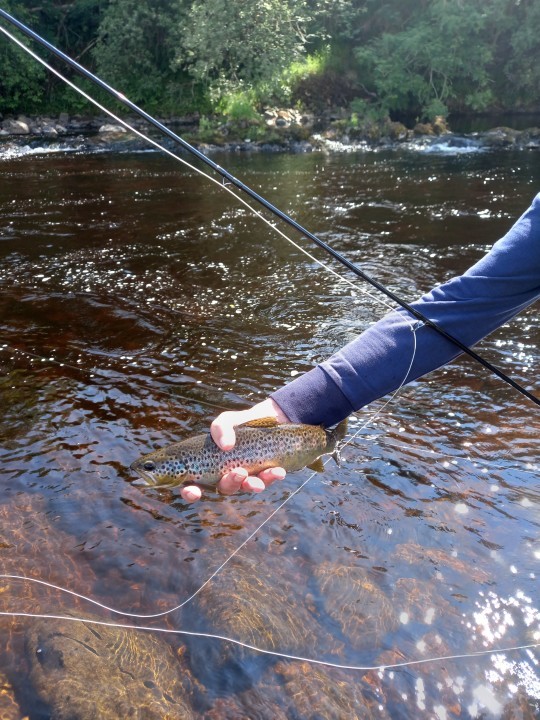 Raby Estate Tees - DN from Northampton
Raby Estate Tees - DN from Northampton 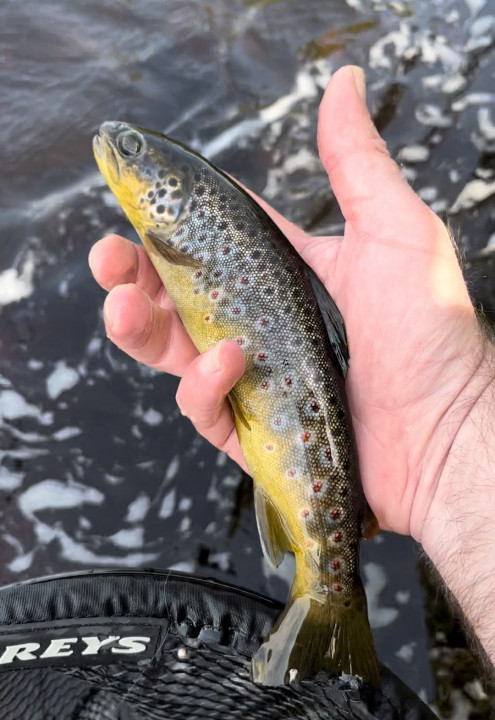 Tees trout - SJ from Stanley
Tees trout - SJ from Stanley Reports from the Welsh Water Company reservoirs in the Brecon Beacons continued to be divided between those who had caught a few trout and were thus satisfied, and those who had blanked and felt they had therefore been cheated. The only comment I can make is that anybody who sets out to fish a large water under a bright, hot sun and with a cold north-easterly blowing at the same time must expect a bit of a challenge. Fish can be caught, but it probably won’t be altogether easy. BG from Exeter took issue with a previous reporter who had complained that easy gravel wading was an inaccurate description for Chainbridge on the Usk. I will try to mediate in the disagreement, by suggesting that some parts of Chainbridge are easy and some parts are not, but when the water is low, as now, with a bit of care you can get to most of the places that matter. BG fished Wood Stream, the flat above the bridge, on an evening ticket. This was at the end of a mayfly hatch and he used a Yellow Wulff and then a Deerstalker, catching trout of 14, 16 and 17 inches. I have often heard it said that the Usk is “not really a mayfly river,” but that isn’t entirely true in the case of the middle and lower sections. Mayfly can’t find a home in an upland river bed of pure rock and gravel, but wherever there are slower currents and pockets of silt for the nymphs to live in they are usually present.
AR from Llanelli fished the Arrow at Hergest Court and caught 9 trout with some mayflies hatching. AF from Stroud fished the same beat on the 2nd June and caught 14 trout on mayfly spinner patterns. PB from Churchdown with a friend had 11 trout including 3 large ones at Craig Llyn with a size 14 Grey Parachute, while SN from Abingdon fishing with dries recorded five trout including two at 16 inches from the Irfon at Aberbwtran. AH from Sherborne spent some time, two evenings and a morning, on the Usk at Penpont and recorded a dozen trout to 16 inches, mainly during olive spinner falls. All this strikes me as good fishing considering that these rivers were down on their bones.
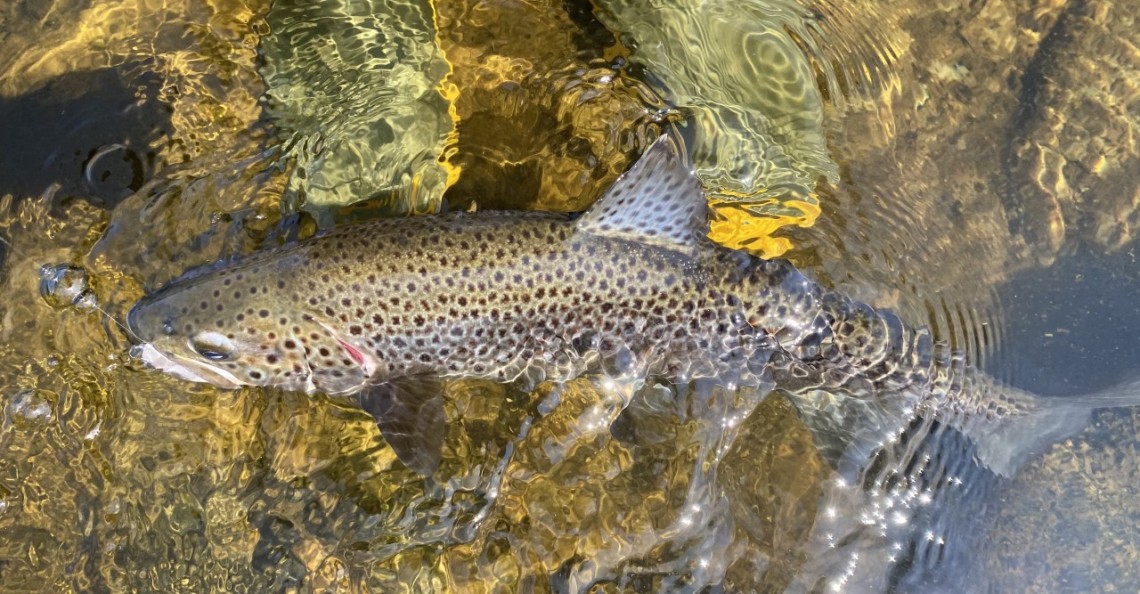 Craig Llyn trout - PB from Churchdown
Craig Llyn trout - PB from Churchdown 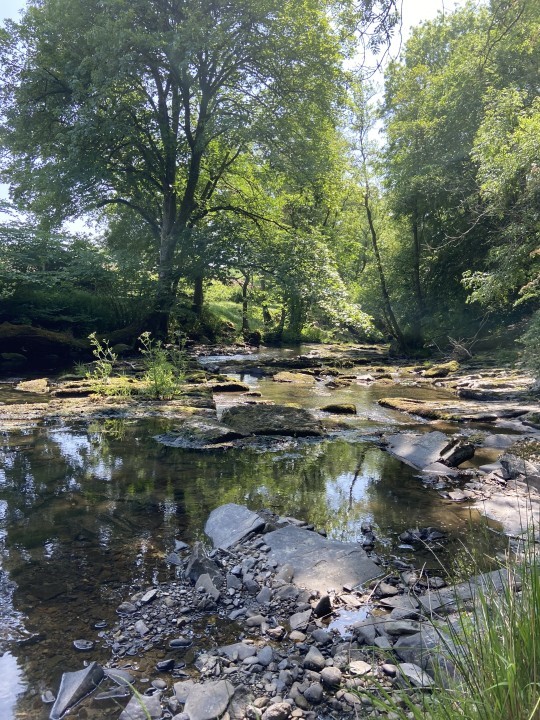 Edw Cregrina - JD from Patricksbourne
Edw Cregrina - JD from Patricksbourne Some problems and questions were also raised. In his reports from the Edw, Joe Alexander of Rhayader queried why so few anglers this year seemed to be fishing the North Herefordshire streams, the Lugg and the Arrow. He may have a point; judging by reports, the take-up of fishing on the various tributaries seems uneven this year. Joe also talked about the need for more winter pruning and I’m definitely sure he has a point there. As one of the original band who started pruning these Wild Stream tributaries a dozen years ago, I would like to think that a younger generation of wild stream fishing enthusiasts might come forward soon to tackle some of this work. The original band was known as “Dad’s Army” and there aren’t that many of us left. Those who are left are rather more decrepit than we used to be. I’m still doing the Forest of Dean ones while I can get around. What is needed I think is someone young enough, fit enough, and probably retired enough to volunteer to organise some of this work on behalf of the WUF portfolio of wild streams.
On the 3rd CT from Cardiff with a friend fished at Cwmwysg Ganol and took 7 trout to 14 inches, mostly in the Quarry Pool. He reported serious problems now with the access to the upper part of the beat with a series of gates and stiles closed off with barbed wire. We have had intermittent problems in the past with difficult access here, but this does sound like a deliberate attempt to keep anglers out and there may be a need for the WUF to approach the landowner concerned. Another report from SJ of Brecon (who had a good day at Dinas taking 20 trout on nymphs) concerned the access gate there which crosses a sloping gravel road. The problem here is that deep holes are developing just above the gate. Users leaving the river stop in the same place to close the gate behind themselves, then spin their wheels trying to get away up the steep slope. The long-term solution is that the landowners make up the road with some puddled concrete or similar. Meanwhile it’s much less damaging (if somewhat onerous) to drive right up the hill from below the gate, dodging the pot-holes as you go through, and then walk back to close the gate.
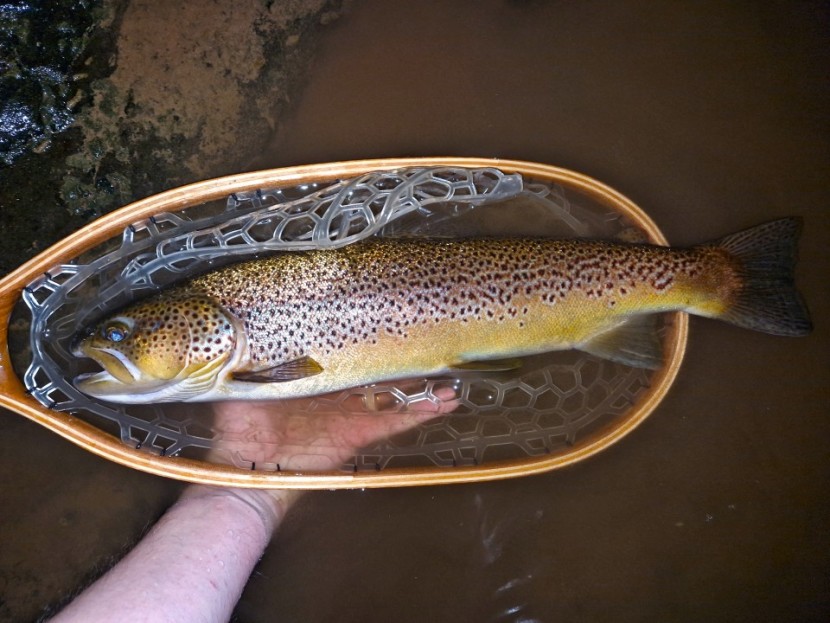 19.75 inch Cwmwysg Ganol trout - BG from Exeter
19.75 inch Cwmwysg Ganol trout - BG from Exeter 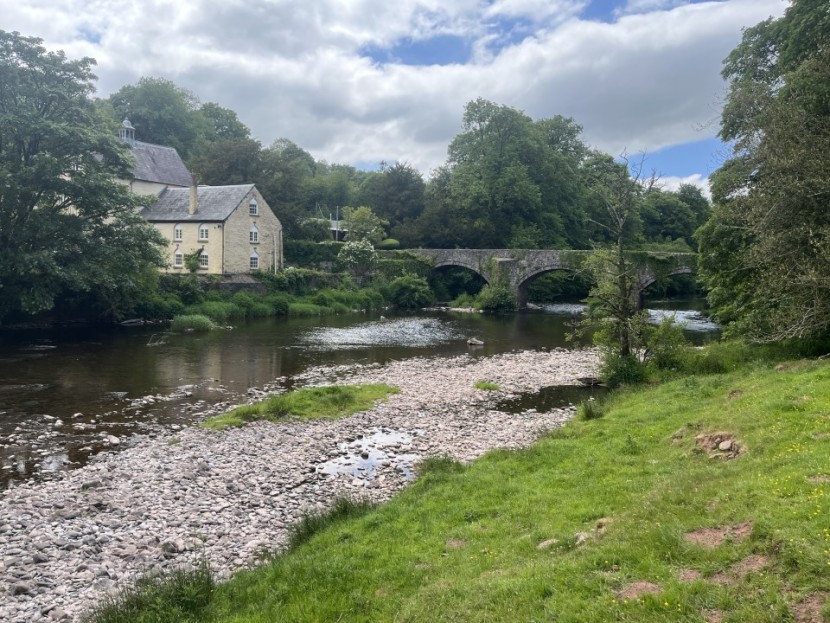 Low water at Penpont - DH from Solihull
Low water at Penpont - DH from Solihull JG from Tonbridge Wells holidaying in the North found a good evening rise on the Tees at High Coniscliffe and caught a sea trout in a bag of 5. JB from Horley with a friend fished the evening at Skenfrith on the Monnow during a spectacular sedge hatch and a spinner fall, accounting for 15 trout. That is unusually good for this part of the Monnow which still seems able to produce at mayfly time. WB from Langenfeld had half a dozen trout on dries one evening from the Usk at Abercynrig, while on the same beat I watched a client take a fish of just under 2 pounds from fast water using spiders. JE from New Malden with a friend took 8 trout, 5 of them over 14 inches, from the shrunken Irfon at Melyn Cildu. DN from Tennessee found his way all the way up to Llyn Idwal, most romantic of lakes in Wales, to catch just one trout. BG from Exeter had a 16 inch fish in a brace taken at Greenbank and queried who owns the opposite bank. Most of it belongs to Llanover, a very highly regarded (and expensive) syndicate.
AK from Churt, who is getting to be a regular, reported 5 fish taken very late in the evening of the 7th at Dinas on Jingler and Elk Hair Caddis patterns. Three of them were 16 inch fish. PW from Leicester had 10 trout from the Strathmore Estate water of the Upper Tees on the 9th, while MR from Winchester reported 6 trout including a big one with nymphs from Greenbank on the Usk. LS from Hereford with two friends had 12 trout from the Usk Reservoir: “a wonderful day,” and BD from Swansea had 6 trout from the same reservoir the following day. It’s nice to hear of anglers enjoying themselves on the Beacons reservoirs for a change. SG from Stone caught 3 trout at Abernant and reported a large shoal of very big barbel lying at the top of the beat. Salmon catches continued to be confined to the bottom of the Wye, PW from St Briavels in the Forest of Dean taking a 12 pounder with a Flying C on 6th June. In fact fresh salmon of different sizes were coming quite regularly into the lower river; Simon Mc Lucas on the 9th reported three fly-caught fish between 10-20 pounds at Redbrook.
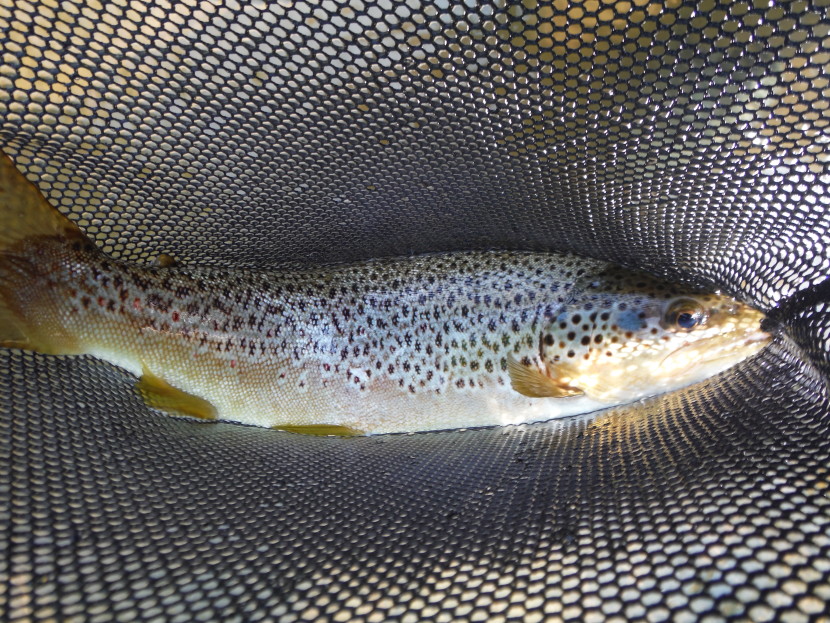 Monnow trout
Monnow trout 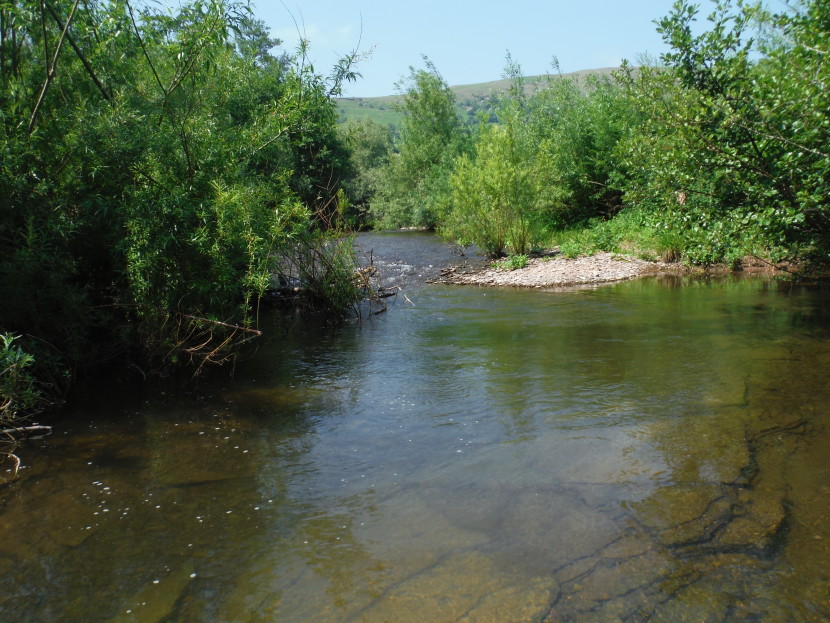 Monnow under the Black Mountains
Monnow under the Black Mountains Pausing for a moment to considering the situation for trout fishing, and given the long drought with cold northerly winds and bright sun, I was quite surprised at how many flies were hatching and how many trout were still rising on our shrunken rivers. At least I hoped in my optimistic way that the waters were not yet overheating as would be likely if the situation continues on through summer. I noticed increasing numbers of fresh water lice on trout caught and also spent time watching large numbers of shad flashing through the pools of the upper Wye. Given the numbers seen, I sometimes wonder why this still needs to be a protected species.
The weather changed during the night of 10th and 11th June as that seemingly relentless north-east wind dropped away at last. The morning of the 11th turned out muggy and warm, with a haze hiding the hills, cloud overhead and the first showers in a long time began to fall. The thunderstorms had some local effect (as when PV from Tilburg found the Dinas beat unfishable due to mud washing in from the Honddu up in the town), but they were not enough to end the drought and as the clouds cleared the heatwave continued. PD from Kidderminster reported 8 small trout on Klinkhammers from the Ithon at Llandewi while SJ from London managed 8 trout from the Usk at Dan y Parc. Despite difficult drought conditions, PB from Abercrave caught 12 trout from the Llandysul AA water of the Teifi. FR from Hereford fishing an evening ticket at Ashford House took 3 trout including a large one. Graham Finch from Banbury had a salmon from Upper Bigsweir on a Yellow and Green Tube. For his part, NH from Truro was annoyed to find himself wired off from his fishing, this time at the upper part of Cefn Rhosan Fawr.
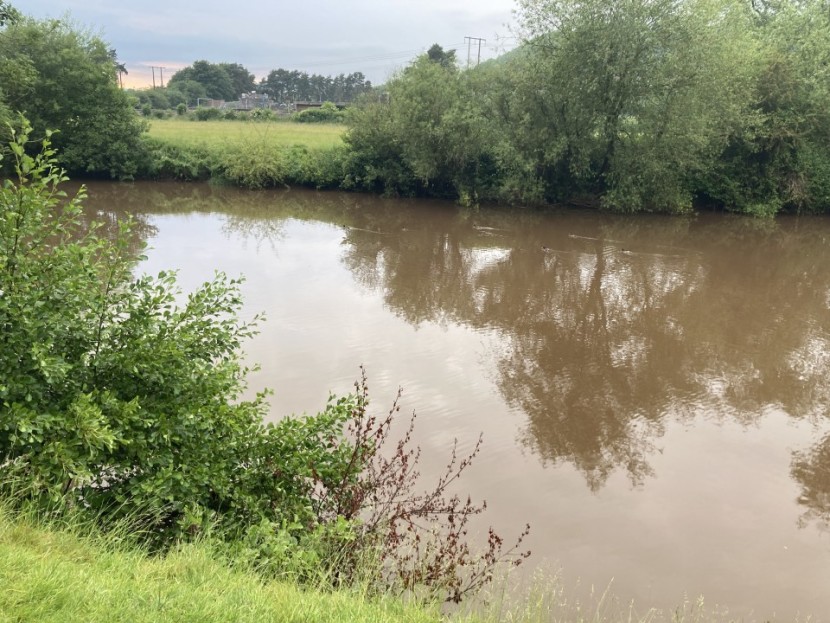 Mud from flooding Honddu - PV from Tilburg
Mud from flooding Honddu - PV from Tilburg 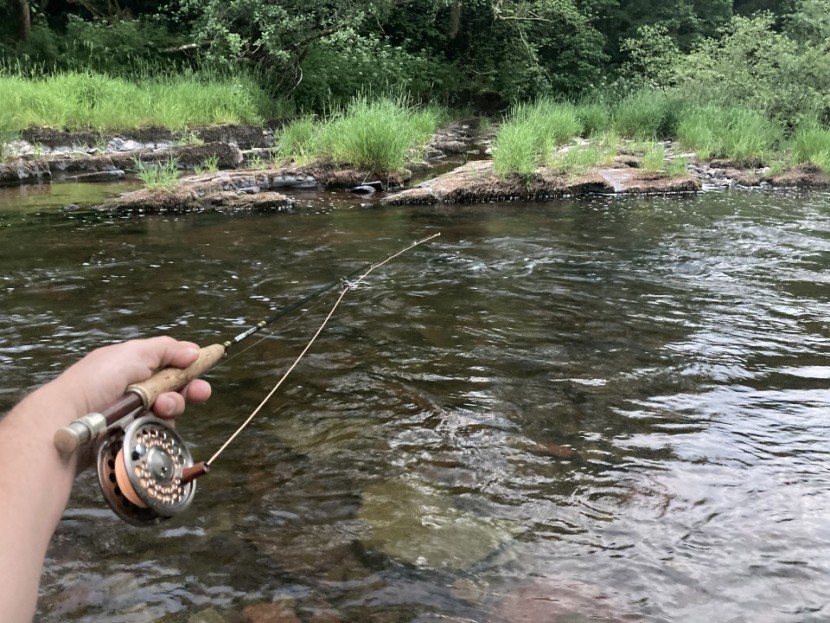 Penpont - PV of Tilburg
Penpont - PV of Tilburg 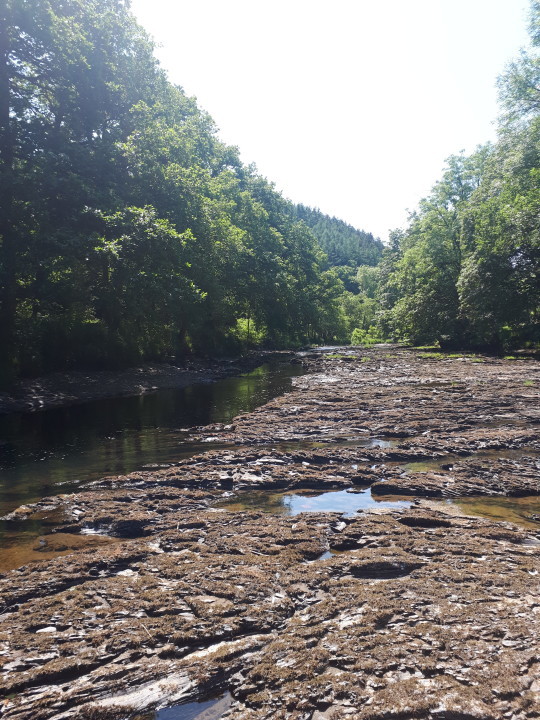 Fenni Fach - AN from Birmingham
Fenni Fach - AN from Birmingham On 14th June the Foundation decided to bite the bullet and closed trout and salmon fishing on Wye beats below Hay and Usk beats below Abergavenny. This suspension would also apply to pike fishing on the Wye when the season opened on 16th June. The cause for the decision was that water temperatures were already hovering around that critical 20 degrees, the point at which large and vulnerable game fish are unlikely to survive catch and release. Coarse fish, it was thought, excepting perhaps big pike, should be able to manage under the same conditions. Unfortunately, these sorts of precautions are necessarily becoming an annual event. Another result of warm water conditions, as we have learned, is that numbers of fresh water lice seem to be increase at a great rate on fish caught on the main rivers. Thankfully, many of the tributaries and other rivers in the region remained below the critical temperatures, so that there were alternatives to offer disappointed Wye salmon anglers. We were also beginning to receive reports of sewin coming into the rivers of West Wales – the fox-gloves are out after all, so it’s the right time to start fishing by night! Apart from information on social media, BG reported a fresh sewin from the Rheidol at Capel Bangor – I hope it went back all right, BG.
16th June and, as usual, the coarse fishing season began with a rush. Reporters from the Wye were about evenly split between those who congratulated those proprietors who had strimmed the access paths leading to the swims on the river, and those who had criticisms for the proprietors who hadn’t taken the trouble to clear the way for their paying guests. In addition, with a heat wave in progress, the silly season was well under way, so many had to catch their fish around canoes, swimmers, campers and barbecue tenders…and even daylight poachers if they were prepared to tolerate them. SD from Slough who fished Home Fishery and then Upper Hill Court on the 16th and 17th June complained about youths “swimming and using spinning rods,” and even asking to buy spinners from his party. So what was done at the time please, JD? Despite all these problems, the low water and ongoing heat, there were some good catches made. RH from Cheltenham caught 30 chub from Fownhope 5; JP from Diss with a friend had 45 chub from the same beat the following day. CW from Swindon with a friend had 34 chub at Foy Bridge, while RH from Leamington Spa had 30 chub and 3 barbel at Lower Carrots and Luggsmouth. NB from Stratford on Avon with a friend managed 40 chub, 1 barbel and a trout from Middle Ballingham and Fownhope No 8. JT from Bath with a friend had 30 chub at How Caple Court, while RS from Coventry had a barbell and 30 chub at Sugwas Court. TH from Swansea with two friends fished the fast water at Wybank for 41 chub and a barbel. JC from Stanford le Hope fishing at Strangford had 44 chub between 3 and 6 pounds, all of them carrying lice infestations. He wondered whether this might be due to spawning, but I think the answer is that the parasites are mainly encouraged by the heat.
Game anglers were still struggling away wherever they could get out of the sun. NJ from Cwmbran managed 7 trout and 8 grayling from Gromaine and Upper Llanstephan. MB from Towcester with two friends caught no less than 129 trout from Cambrian AA’s Llyn Conlog. MG from Aberdare with a friend caught 30 trout and 34 grayling from Dolgau on the Upper Wye. MH from Swansea had 18 trout and 5 grayling, including fish of 2 and 2.5 pounds, from Gromaine and Lower Llanstephan. TR from Derby was unhappy with his day at Ashford House, having tried to find it by post code: “Absolute nightmare to find…only found it by accident after stopping to look at the notes…lost the will to fish.” There is a lesson in this, which is to read the notes carefully to begin with and not to worry so much about post codes. Ashford House is not so difficult to find, as those of us who remember the world as it was before satnav was invented will know.
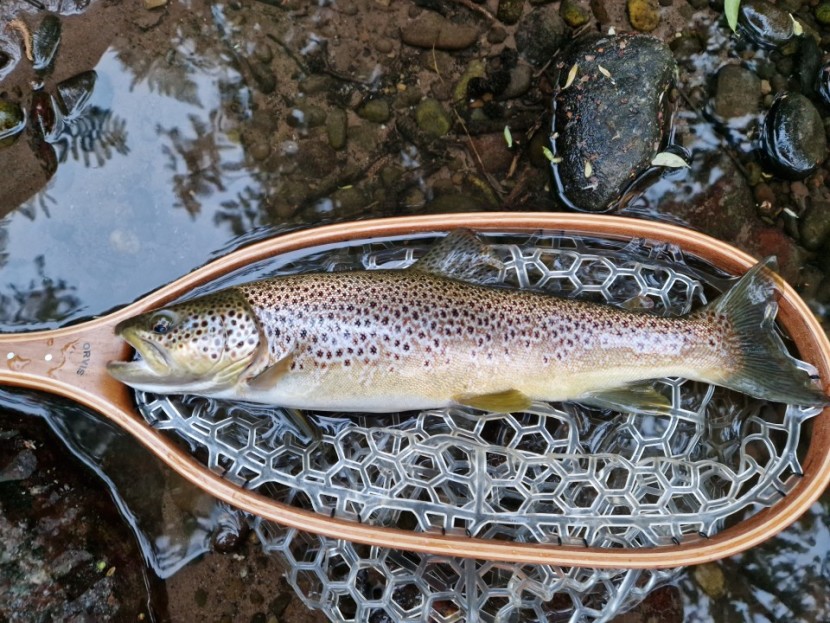 Chainbridge trout - BG from Exeter
Chainbridge trout - BG from Exeter 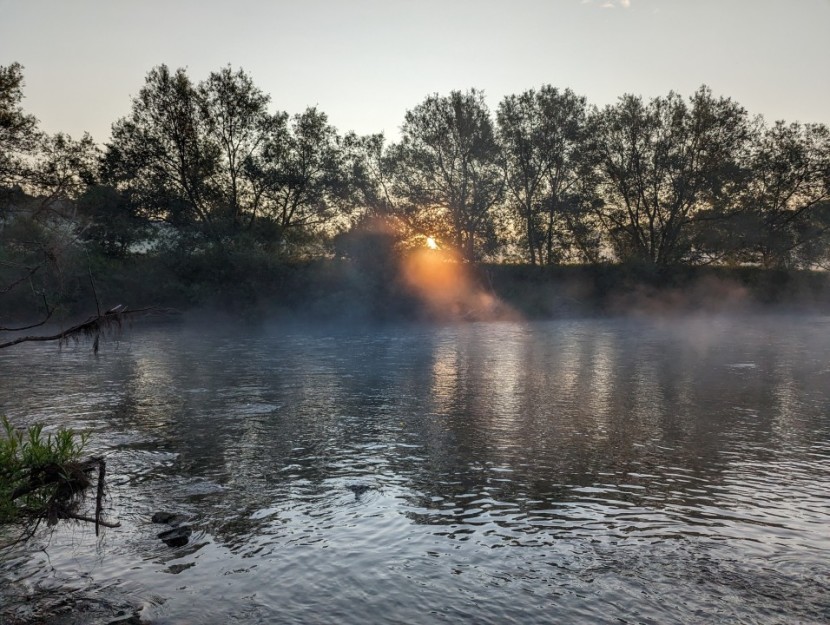 Morning at Wyebank - CM from Keynsham
Morning at Wyebank - CM from Keynsham We were all praying for rain by now and in fact the weather was changing with some big cumulous clouds in the offing. Very localised thunder storms were quite powerful with heavy downpours turning tributaries muddy – some anglers were even washed off by muddy water. Then on the early morning of the 20th we experienced a proper weather front with about 3 hours of steady rain as it passed across. This was very acceptable to gardeners and farmers, but did not seem to have much effect on the rivers. GD from Knutsford and IH from Faversham both reported big catches of chub and barbel from the Home Fishery.
Having had his salmon fishing day at Goodrich Court with me cancelled due to the water temperature, Cedric Leavy of Geneva, quite a well-known match fisher in European circles, decided to accept a trout and grayling day me on the Lugg at Lyepole. Cedric as a traveller has been a bit unlucky with his attempts to engage with Atlantic salmon; arriving in Iceland last summer, he was confronted with an air temperature of 36 degrees. We had hoped for a few late mayfly at Lyepole; these didn’t materialise, but instead I had the pleasure of watching him extract 30 grayling and 6 trout from the Lugg using heavy nymphs fished on a long leader outfit and trickled very slowly along the bottom, even in fast flows.
David and I had yet another hot day on the Wiltshire Avon at Heale, again hoping for some late mayfly action. Despite warm sun, there was a strange sort of sea fog over the downs as we arrived. To my surprise, a combination of local rain showers and a lack of weed cutting had put this chalk stream up to near its maximum level and hatches had been opened further to let extra water through. As it turned out, we saw only a handful of natural mayflies and big artificial flies wouldn’t work. Instead I used a size 14 Parachute Adams all day and we both did very well, with nearly 40 good trout between us plus a few of the dark Avon grayling. The water was cold compared with our freestone rivers and I saw no lice on fish.
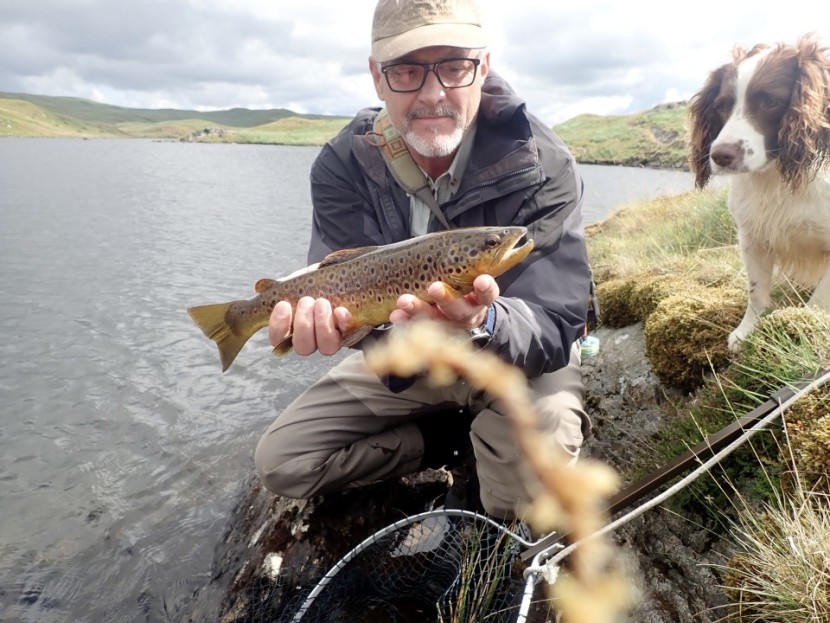 Llyn Hir trout - PB from Leominster
Llyn Hir trout - PB from Leominster  Lyn Davies on Llyn Berwyn
Lyn Davies on Llyn Berwyn SL from Hereford had serious complaints to make about the Dore at Chanstone Court, which he fished on 22nd June. I have not had the opportunity to see that Wild Stream this season, but it was in a bad state last year and according to SL it has not been maintained in a long time. SL surely has a point. The problem is that some years ago Chanstone Court and several neighbouring Dore beats were coppiced badly in that the alders and willows were cut back so drastically that there has never been a chance for a high canopy to develop. Instead there is a new mass of low-level shoots obstructing the river every season. I had understood that this beat, along with other Monnow tributary beats, had been adopted by volunteers. If the adopters no longer feel able to undertake this work, they should surely let the WUF know and perhaps others will be encouraged to step forward?
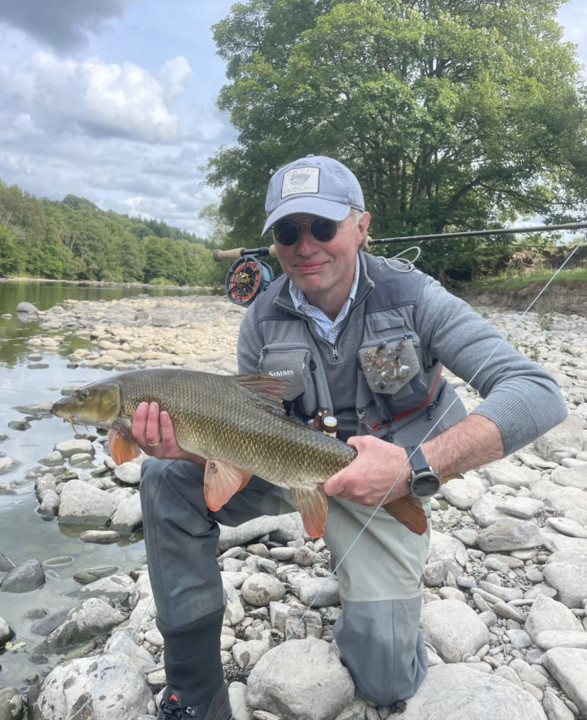 Barbel on the fly - EW from Cooksbridge
Barbel on the fly - EW from Cooksbridge JA from Rhayader fished the little Edw at Hergest for 6 trout and mentioned there is a very large brown bull in a field with cows on the approach to the beat. I can’t really comment on that beyond remarking that bulls in company with cows tend to be relaxed. I always keep an eye on cattle and tend to base my movements on the mood they seem to be in. And don’t take a dog with you! BG from Exeter fishing the Usk at Cwmwysg Ganol on an evening ticket had an excellent trout measured at 19.75 inches in his bag of four. SW from Normanton had 15 trout and 20 grayling from the Dee at Llangollen Maelor. KM from Caerphilly reported a sea trout from Llwyn On, which is unusual to say the least. Lyn Davies sent in a report from Llyn Berwyn, where he took 9 trout with a wind and a good ripple going. I think Lyn tends to use a pair of dry flies under these conditions. MN from Bristol had a good day at Craig Llyn on the upper Wye, taking 5 trout to 16 inches and grayling to 17 inches, all on nymphs. Generally, though, the game fishing was difficult in the continuing low water and hot sun. There were no salmon reported in this period and the lower Wye in any case was still closed for salmon fishing due to the heat. Coarse fishing activity was tremendously busy and many anglers were successful although chub featured more in the reports than barbel. EW from Cooksbridge was one who at Ty Newydd took a 70cm barbel on the fly. See the photograph with the rod carefully balanced, salt water guide-style, across the captor’s shoulders.
As an example of the coarse fishing, MH of Swindon with two friends fished for three days on middle Wye beats and provided us with the reports. The first day was at Holme Lacey 3 and Lechmere’s Ley when a total of 200 chub and 3 barbel were taken: “first of three days back on the wye begins here at holme lacey 3 and no better place to begin all three of us catching some lovely chub and barbel excellent start hopefully the next two will be as good” This was followed by Day Two at Home Fishery, where the trio accounted for 97 chub and 3 barbel.
However, sadly the third day at Whitehouse which involved catching 34 chub and an eel was not considered a success: “Day three and final day for are trip on the wye again first time on this beat the back trop and surroundings area is nice but unfortunately that is where it ends before we began to fish we walked the hole stretch to say this is excellent fishing is NOT QUITE TRUE the top end was absolutely abysmal which is a shame with some work done on it you could make at least 8 to 10 swims so say that there was a mile of fishing not the case we payed good money for this beat well we felt we had been mugged plus the noise of the pump going ALL DAY is a shame so we all agreed that you could looking at 400 yds or so of fishing as for the fishing we did managed to get some fish out but unless there is some work done on the top end we all agreed we definitely not return.”
I’m a bit out of breath after all that, but it seems we failed at the last fence to please Mugged of Swindon and his party. The message to fishery owners from this client and others is surely that you need to do a bit of strimming to improve the access for anglers at the beginning of the season, at least if you want to have a favourable trip advisor report.
Finally and quite apart from the actual catch numbers, let’s hear from a couple of anglers who did enjoy their fishing during this hot summer month. PJ from Crediton with a friend fished at Dinas: “Fishing Passport is the best thing since sliced bread. So easy to use and great water.” And from AC of Bristol who fished at Upper Hill Court: “Short evening session. Didn’t see another soul from when I started at 18.30 until I packed up at dark, bliss. Great fishing, almost non-stop action, finished with 5 nice chub and 2 barbel, biggest 8 pounds 13 ounces. All came on boilie fished just a gentle underhand lob out using my old centre pin, no need to launch a great bomb across the river. Fed a dozen or so boilies over the top by hand every 15 minutes and that was it, simple leger rig. No need to chuck loads of bait in.”
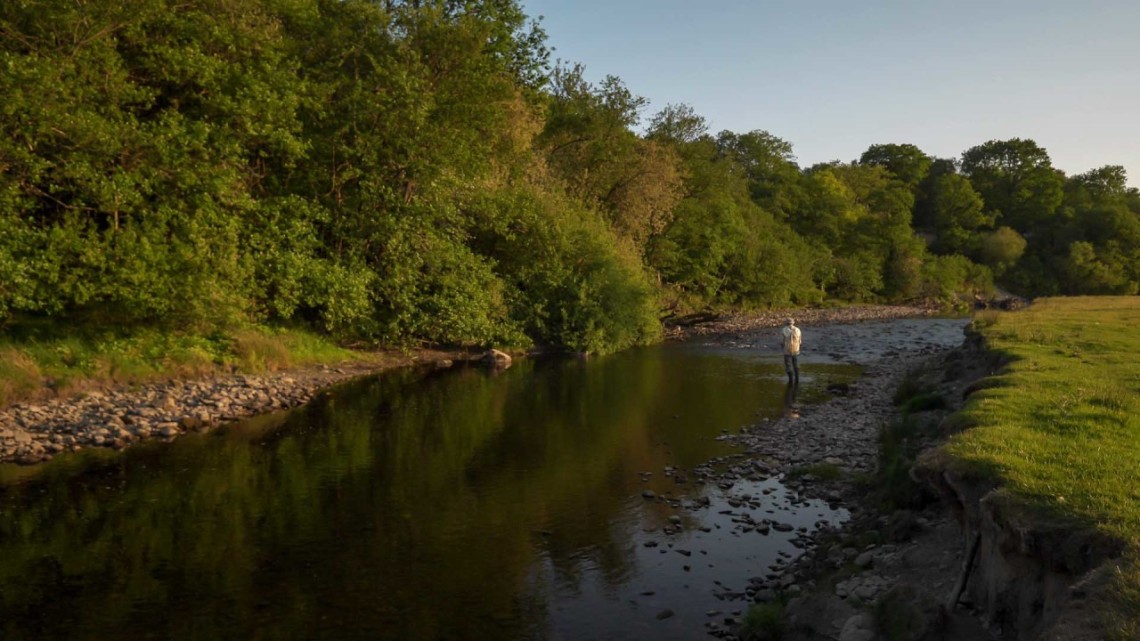 Colonel's Water - MB from Bude
Colonel's Water - MB from Bude 24th June was a fascinating day. I was working on the river but glued to the radio while driving up in the morning, during the lunch break and driving home again that evening. It seemed there was a military rebellion under way in Russia and scenes on Moscow streets with hastily erected machine gun nests and barricades of barbed wire must have been similar to those portrayed in the movie Valkyrie, which recreates Berlin in 1944 and the coup attempt against Hitler. It was discovered that the Wagner mercenary group, technically a private military company, having taken over the southern city of Rostov on Don from which all the military operations against Ukraine are launched, already had a column of troops on the motorway within 150 miles of the Russian capital. There had been early clashes with the Russian Airforce. Wagner leader Yevgeny Prigozhin was demanding the resignations of the Russian Defence Minister and the Chief of Staff. Vladimir Putin, visibly furious, made a statement that mutineers and traitors to the state faced arrest and harsh punishment. Western political commentators, more than surprised by the speed of events, began to speculate on what dealing with a nuclear armed Russia ruled by Yevgeny Prighozin rather than by Vladimir Putin might be like. Not a happy thought.
And then, somehow, the threat mysteriously died away. The Wagner column on the motorway turned around and headed back south while Wagner troops pulled out of Rostov in order to return to base. Prigozhin made a statement that “in order to avoid bloodshed” Wagner troops were standing down. Prighozin himself would leave for Belarus. There was some kind of fiction that Belarusian leader Lukashenko had acted as a mediator in making a deal. Putin made a second announcement also using the phrase that “in order to avoid bloodshed” no charges would be laid against Prigozhin or his mutineers. It’s not like Putin to make a U-turn and come up with completely opposing announcements in the same day. Prighozin later in the evening made a long and rambling statement explaining that his action had been due to frustration with the Defence Ministry but had not been aimed at the Russian state.
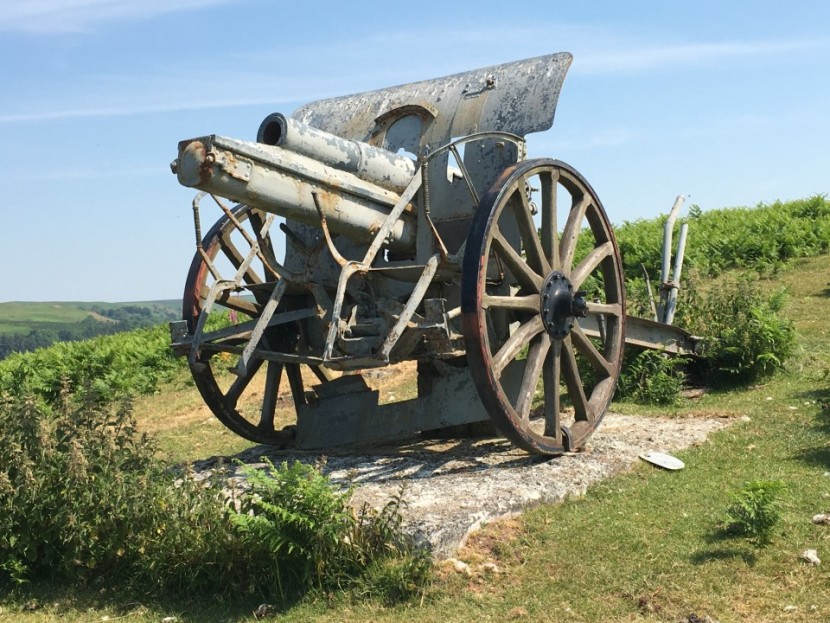 The Garth Gun - PB from Churchdown
The Garth Gun - PB from Churchdown It was fascinating to wonder what had really happened. How was it possible for the Wagner Group to take over all military facilities including the airport in the great city of Rostov on Don without a shot being fired? Just how popular is the Wagner Group there? Were elements in the regular Army waiting to see which way to jump? Will Minister of Defence Sergei Shoigu and Chief of Staff Valery Gerasimov keep their jobs? And what odds would you give for the long-term survival of Prigozhin now? (Best stay away from open windows for a while, somebody advised him). In fact Russian blood had been shed, the Wagner column having shot down six Russian aircraft during their advance on Moscow. Within a few days Putin had made further statements implicitly acknowledging Wagner Group as his own creation with a billion USD of state funding, again threatening further action against traitors, but offering ex-Wagner members a free pardon and enrolment in Russian regular forces. Those unwilling to accept seem to be gathering around Prighozin in Belarus – exile in theory, but not so far away from Russia or Ukraine. All of which is oddly enough reminiscent of the troubles Turkish sultans had with the unruly Janissary Corps, finally ended in 1826 by Mahmud II with a bloody massacre of 4,000 remaining Janissaries in Constantinople. There’s nothing new under the sun, as my old history master used to say. Whatever the truth of it, Putin’s own credibility must be seriously damaged and the Ukrainians and some of their supporters are understandably cock a hoop. However, western observers inclined to be optimistic should remind themselves that the Prigozhin position, apparently quite popular in Russia, was not a protest against the Ukrainian war, but more a complaint that it has not been prosecuted efficiently enough.
The air temperatures had fallen slightly but our rivers were still in trouble as far as game fish were concerned. We desperately needed rain and this now looked like being the fourth year of drought. On the last day of the month, a cloudy and cooler day, rain did fall intermittently but it was plain that more would be needed to push the warm water out to sea. Reports from Scotland indicated a poor salmon run there. Earlier this year the Wye and Lugg ecological status was re-designated by Natural England from “unfavourable – improving” to “unfavourable declining.” What does that actually mean? Those of us who fish the system regularly believe that the situation is more nuanced than that. The results of anglers are to my mind at least as good a guide as the electro-fishing surveys of the scientists, but these are worrying times and those of us who care about the purity of our rivers cannot afford to relax.
Oliver Burch